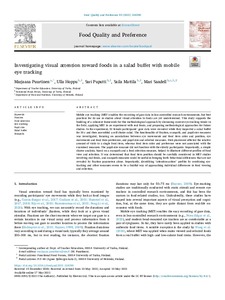Investigating visual attention toward foods in a salad buffet with mobile eye tracking
Puurtinen Marjaana; Hoppu Ulla; Puputti Sari; Mattila Saila; Sandell Mari
https://urn.fi/URN:NBN:fi-fe2021093048104
Tiivistelmä
Mobile eye tracking (MET) enables the recording of gaze data in less-controlled research environments, but best practices for its use in studies about visual attention to foods are yet undetermined. This study supports the building of a coherent framework for this methodological approach by discussing current eye-tracking trends in the field, applying MET in an experiment with real foods, and proposing methodological approaches for future studies. In the experiment, 32 female participants’ gaze data were recorded while they inspected a salad buffet for 20 s and then assembled a self-choice salad. The functionality of fixation, scanpath, and pupil size measures was investigated, focusing on associations between eye movements and food item color and position, eye movements and food item preference, and pupil size and selected measures. Dish placement affected the relative amount of visits to a single food item, whereas food item color and preference were not associated with the examined measures. The pupil-size measure did not function with the elderly participants. Importantly, a simple cluster analysis, based on a scanpath and a food selection measure, helped to illustrate different profiles of food view and selection. It was determined that food item position should be carefully considered in MET studies involving real foods, and scanpath measures could be useful in bringing forth behavioral differences that are not revealed by fixation parameters alone. Importantly, identifying “attention-action” profiles by combining eye-tracking and other measures seems to be a fruitful way of approaching individual differences in food viewing and selection.
Kokoelmat
- Rinnakkaistallenteet [27094]
